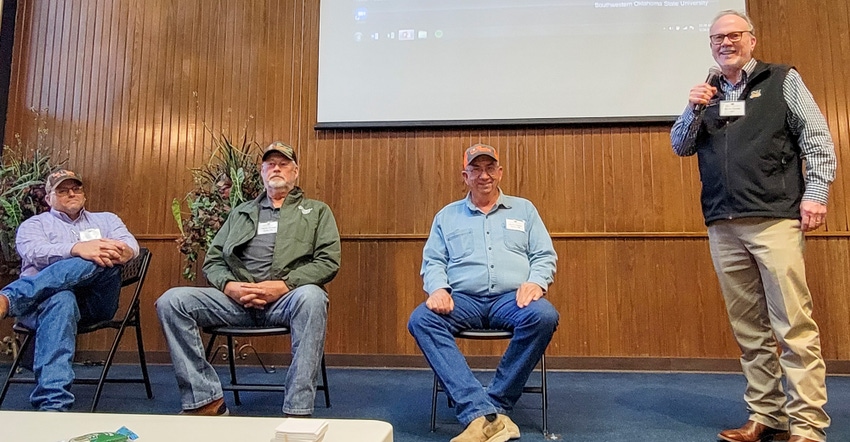
The biggest challenge for 2022, by far, for three experienced, successful Oklahoma peanut farmers will be managing costs.
Merlin Schantz, Charles Keahey, and Justin Miller discussed how they are approaching the season during a panel discussion at the recent Oklahoma Peanut EXPO in Weatherford.
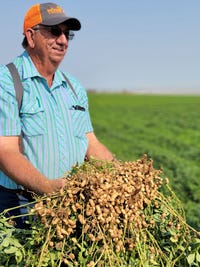 Merlin Schantz, Hydro, Okla., producer. (Photos by Shelley E. Huguley)
Merlin Schantz, Hydro, Okla., producer. (Photos by Shelley E. Huguley)
They covered key pre-plant and in-season management decisions they will consider for the upcoming crop, including fertility, tillage, planting rates, weed management and irrigation.
Expectations
They began with expectations.
Schantz, who farms near Hydro, has grown peanuts for 33 years. “Our biggest challenge this year is finding and figuring out how to pay for inputs,” he said.
Keahey, Erick, Okla., has grown peanuts for more than 20 years, adding the crop, “when my wife and I decided we couldn't make a living farming wheat. Early on if we weren't making 4,000 or 4,500 pounds, we worried. Now, if we can't make 5,000 pounds, we're really in trouble.”
He said rising input costs push yield goals. “Everything gets tighter. We have had several circles that almost hit 7,000 pounds. We've never reached that goal, but we're working on it.”
Miller farms just north of Erick with his family and has been growing peanuts since the mid-90s.
“Money got tight, times got tough, and we had to look for something different. We settled on peanuts.”
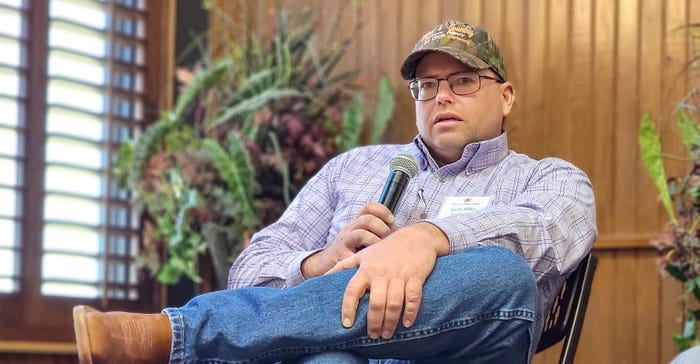
Justin Miller, Erick, Okla., producer.
Our challenge, like everybody else, is the cost and availability of inputs such as fertilizer,” Miller said.
He said they set higher yield goals to make a profit. “We broke the 7,000-pound mark one time. Our low last year was around 5,400. Our high was knocking on the door of 6,400.” He said one pivot made less than 5,900 pounds, another one was just over 6,000.
“We were scratching our heads trying to figure out what we did wrong. If we can't make the pounds, you know…;”
Cost factors
Fertilizer availability and cost will be an issue.
Miller said he will rely on compost as a main nutrient source. “We will strip-till and run some liquid fertilizer in with the strip till. Normally, we don't put herbicides on until after we plant. We use residuals and we water them in.” Keahey said pre-watering will be “a must this year. We like to plant in moist soil and need as good soil/seed contact, as possible. The stand needs to all come up within 36 hours. Anything past that can be considered a weed.” He said if he doesn’t get inoculant into moist soil it will die. “It dies in a short time in hot soil.”
Timing, timing, timing
Timing is critical, he said. “With herbicides and everything else it's all about timing, timing, timing, and timing. If you drive by a field and see weeds, you’re too late. You need to be out there on your hands and knees trying to find a weed. If you find one, you need a contact herbicide and put down a residual at the same time.
“We apply liquid inoculant in-furrow. We have been using a rate-and-a-half.”
Know field history
“When you're trying to raise high yield peanuts, I guess one of the first things that comes to my mind is knowing your field,” Schantz said. “Know the field history, the disease history.”
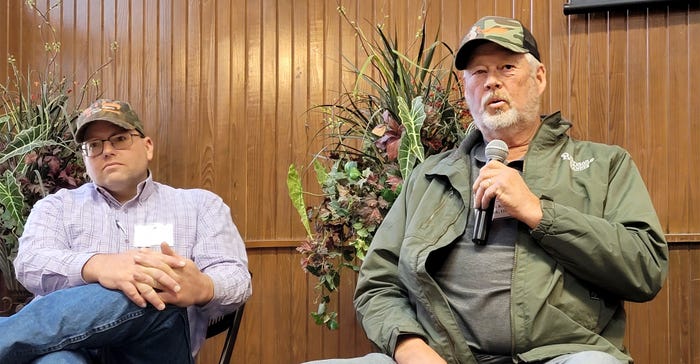
Justin Miller, left, with Charles Keahey. Keahey says timing is critical in peanut production.
He said in fields with a history of pod rot, for instance, producers need to pay attention to variety selection since susceptible varieties are more likely to require fungicides.
“Also with peanuts, we have to control weeds pre-plant. We don’t have a whole lot of good options for contact herbicides. Be ahead of the eight ball on weed management and on disease as well.”
He recommends taking stock of wildlife issues. “Feral hogs are a big problem, and deer can be too.”
Clean till
Schantz clean-tills peanuts. “I’m probably the only farmer in Western Oklahoma who still plants peanuts clean till. I pull a moldboard plow, primarily for weed management. Yellow herbicides work much better when mechanically incorporated. Peanuts are the only thing I plow.”
Rotation makes a difference, Schantz said. “I follow at least a four-year rotation on peanuts. We're rolling that ground over once every four years.”
He added that the tillage and rotation program works well but requires some extra management to keep the ground from blowing. “We like to have good soil moisture when we're seeding. Last year, I just pulled my air seeder right ahead of the planter. I like to get a ridge on the soil surface, right ahead of that planter; that helps break the wind a little bit.
See, Oklahoma peanut acres down, quality and yields up
“Peanuts come on pretty quick and cover the soil to manage blowing sand.”
Gypsum advantage
Schantz said he has not changed fertility much in recent years. “We’ve been applying gypsum, pre-peg. It helps with pegging, but it also helps at harvest time in tighter soils. It allows us to dig a little cleaner peanut.”
Both he and Miller said they add little additional fertilizer to peanuts in rotation. “I use a liquid inoculant in-furrow and sometimes add fungicide and insecticide with that,” Schantz said.
“We do the same thing on our liquid,” Keahey said. “We usually run 4 to 6 ounces of Abound with it. We use a 10 - 34 - 0 starter fertilizer on a two-to-two band. We apply all of our phosphorous and potash, specifically the potash, in the fall after harvest. We come back with 10 - 34 - 0 when we plant in the two-to-two band.”
“In the past we've used a combination of twin-row and single-row,” Miller said. “Last year we were 100% twin row.
“We make sure to apply at least a one-and-a-half rate of inoculant. We soil test every year and base fertilization on the soil test. Whatever that soil test recommends, we follow.”
He adds about 30 pounds of nitrogen, pre-plant on peanuts. “Last year we put out some liquid through the pivot in-season, but I don't think we saw benefit from it.”
Miller said seeding rates for twin or single rows are the same but depend on the variety. “Generally, we plant about 4.8 to 5.5 five seeds to the foot.”
Irrigation
Irrigation management remains as much art as science, panelists said.
“We have soil probes,” Keahey said. “But the main thing is to watch the crop. If we see a sign of stress, it’s time to water. We have occasionally overwatered one pivot with a good well and tighter ground. We can grow vines that will get over knee high and it doesn’t yield as well as pivots with smaller vines.”
He said peanuts need more water at flowering. “Typically, we put on what we can put on.”
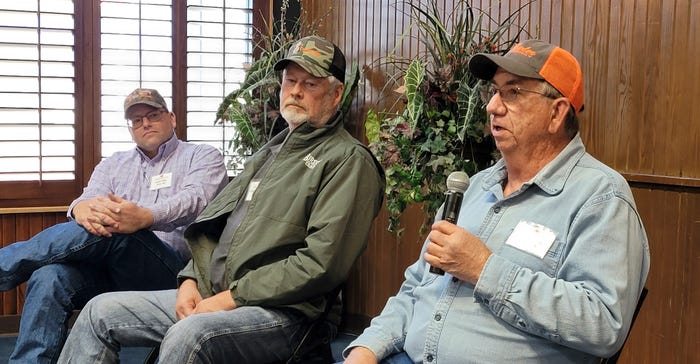
Schantz likes the idea of technology to manage irrigation but is not sold on the practicality.
“If I can predict the weather, I know how to water. Under most pivots, we need all the water available. I don't think we've ever had a situation where we applied too much. We usually run short."
Schantz said he occasionally might water as early as June, depending on the weather. “Typically, we don't pump a lot of water until peanuts start to peg. And from then on, it takes all the water we have.”
See, Preplanning is key to 2022 weed management programs
He’s worked with Oklahoma State for several years on numerous irrigation projects. “We've had a lot of probes and sensors in the field, but it really boils down to you can't forecast the weather. I like the concept, but to make that fit into a farm economically is hard.
“If you know it's gonna rain next week, you wouldn't irrigate, but I usually don't know that. What's even worse, I usually know it’s not gonna rain.”
All three panelists know 2022 will be challenging. It’s starting off dry. Inputs are expensive. Some products will be hard to find.
Relying on the management programs that have served them well for many years will provide them the best opportunity to make the pounds that will give them a chance of eking out a profit.
About the Author(s)
You May Also Like






